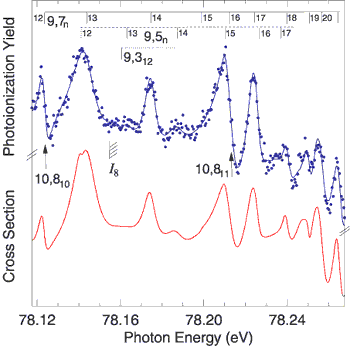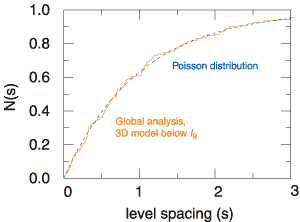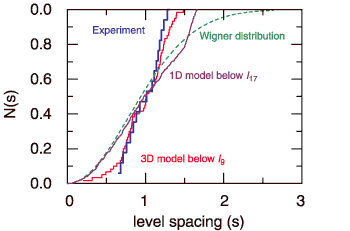
Quantum Chaos in Helium
Two's a party, three's a crowd—especially in a tiny space. Two objects that exert electrostatic or gravitational forces on each other have relatively simple dynamics: the forces scale as the square of the distance between the objects. A three-body system, however, cannot be solved analytically (it is nonintegrable), which indicates that the dynamics involve a mixture of regularity and chaos. Add to that the constraints of quantum mechanics, and things get truly challenging. Now, an investigation into the transition from quantum dynamics to chaos in the spectrum of helium has shed a little bit of light on one of physics’s blackest boxes—quantum chaos.

|
||
|
Since the work of Poincaré a century ago, the problem of
three bodies interacting under their mutual gravitational forces
(such as the earth, moon, and sun) has been known to exhibit a mixture
of classical and chaotic dynamics. A system of three charged particles
should have similar dynamics (within a sign), even in very small
systems. But as yet, scientists don't know how to reconcile chaos
with a quantum mechanical view of the universe. Classical dynamics
allows for the chaotic motion of three bodies, because the mechanics
can be described with nonlinear equations of motion; quantum mechanics,
however, does not have this way to account for chaos, because the
Schrödinger equation is linear. Furthermore, the quantum states
of the helium atom, the prototypical three-body charged-particle
system, occur in seemingly regular progressions, labeled by sets
of quantum numbers. How, then, can classical mechanics and quantum
mechanics be reconciled? What are the manifestations of the underlying
classical chaos in the quantum spectrum of helium?

|
Understanding Chaos |
|
To answer these questions, an international group working at Beamline 9.0.1 (now Beamline 10.0.1) has used the bright beams of the ALS along with theoretical modeling to search for quantum chaos in the photoabsorption spectrum of helium—and they’ve found it. The high brightness on this undulator beamline allowed the resolution (about 2 meV) necessary to distinguish tightly spaced states near helium’s double-ionization threshold. Electrons in these high-energy, doubly excited states are known to show more classical behavior than those lying closer to the nucleus. But the states are so close together that a third-generation light source is needed to resolve them. The resulting spectrum was compared to a new theoretical model based on a random matrix approach to chaotic systems. Agreement between the model and the data was excellent, allowing the experimenters to extend the statistical analysis even to states above those seen in the experimental spectrum. The electronic states of doubly excited helium can be labeled as N,Kn, where N is the principal quantum number of the inner electron, n is that of the outer electron, and K is the angular correlation between the two. States with the same N converge to an ionization threshold, IN. The researchers found that, as the electron energies approach the ionization threshold for electrons with higher N, the statistical properties of the spacing between neighboring energy levels clearly display a transition toward quantum chaos. Where IN >4, the N–1 series begins to be perturbed by higher series. Where IN >8, the effect is strong enough that traditional quantum numbers can no longer describe the dynamics. Statistical analyses also showed that, as IN increases, plots of the spacings between nearest-neighbor states move from being best described by a Poisson distribution (associated with regular systems) to more closely approximating a Wigner distribution (associated with chaotic systems). This observation of the onset of chaotic dynamics in a simple three-body system shows, for the first time, how the underlying classical chaos manifests in a simple and well-studied quantum system. 
Research conducted by R. Püttner, M. Domke, M. Martins, and G. Kaindl (Freie Universität Berlin), B. Grémaud and D. Delande (Université Pierre et Marie Curie), and A.S. Schlachter (Berkeley Lab). Research funding: Deutsche Forschungsgemeinschaft, Bunderminister fuer Bildung und Forschung, and UMR 8552 of CNRS. Operation of the ALS is supported by the U.S. Department of Energy, Office of Basic Energy Sciences. Publication about this research: R. Püttner, B. Grémaud, D. Delande, M. Domke, M. Martins, A.S. Schlachter, and G. Kaindl, "Statistical Properties of Inter-Series Mixing in Helium: From Integrability to Chaos," Phys. Rev. Lett. 86, 3747 (2001). |
||
More ALS Science